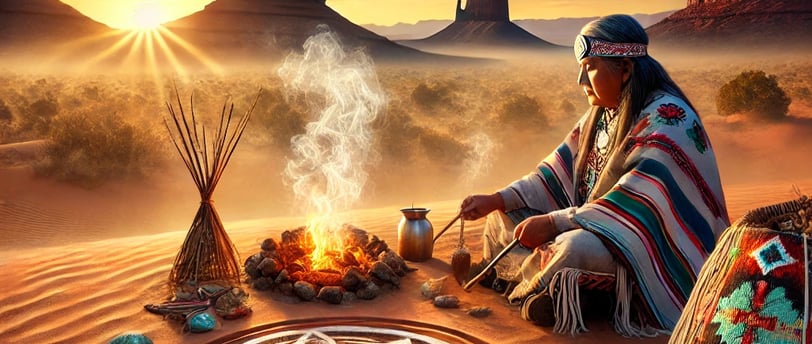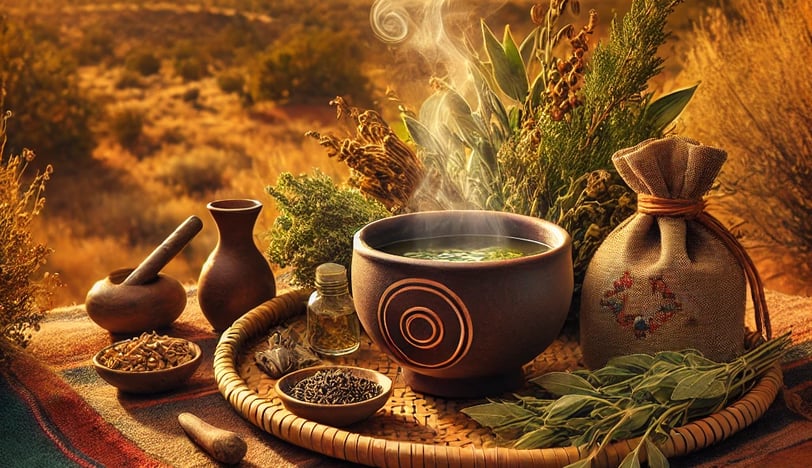A Native American Medicine Bag
Medicine Bag and other Herbs for Health
NATIVE AMERICANS
Lily
2/18/20256 min read


A Native American medicine bag (or medicine pouch) is a small, personal bag that holds sacred items believed to offer protection, healing, and spiritual connection. The contents vary depending on the individual, their tribe, and their spiritual beliefs. Some common items include:
Sacred herbs: Sage, sweetgrass, cedar, or tobacco for smudging and prayer.
Stones or crystals: Chosen for their spiritual or healing properties.
Animal totems: Small bones, feathers, or claws symbolizing spirit animals.
Personal items: A lock of hair, a special bead, or a small gift from a loved one.
Prayer bundles: Small cloth bundles containing herbs or special prayers.
Symbolic charms: Carved wood, shells, or small objects representing protection and guidance.
Each medicine bag is deeply personal and often kept private, only opened in sacred or personal moments.
A Navajo (Diné) medicine bag is a deeply personal and spiritual item, often used for protection, healing, and connection to the natural and spiritual world. While the exact contents vary from person to person, they often include:
Common Items in a Navajo Medicine Bag:
Sacred Herbs – Sage, cedar, or juniper for purification and protection.
Corn Pollen (Tádídíín) – Used in ceremonies and prayers to promote harmony and balance.
Turquoise – A sacred stone in Navajo culture, symbolizing protection, luck, and spiritual connection.
Animal Parts – Feathers (especially eagle or hawk), small bones, or fur representing spirit guides.
Blessed Earth or Sand – Collected from a sacred place or a sand painting used in healing rituals.
Shells or Stones – Representing the four sacred mountains of the Navajo homeland.
Personal Items – Small trinkets, carvings, or symbols of personal or ancestral significance.
Navajo medicine people (hataalii) use sacred items in healing ceremonies, but personal medicine bags are often carried for protection and spiritual balance. These bags are treated with deep respect and are usually kept private.
Navajo (Diné) Healing Traditions
The Navajo healing system is deeply spiritual and focuses on restoring hozho—a state of harmony, balance, and beauty within a person and their surroundings. Healing is performed by hataalii (medicine people), who use sacred songs, prayers, and ceremonies to treat illness, both physical and spiritual.
1. The Role of Hataalii (Medicine People)
Hataalii are trained for years to learn chants, sandpainting techniques, and herbal remedies. They diagnose and treat ailments through spiritual insight, divination, and ceremonial practices.
2. Healing Ceremonies
Navajo ceremonies, called “chants” or “sings” (hózhǫ́ǫ́jí), range from short rituals to nine-day ceremonies. Some of the most well-known include:
Blessing Way (Hózhǫ́ǫ́jí) – A ceremony for protection, purification, and harmony, often performed for pregnant women, new homes, or before major life changes.
Enemy Way (Ndaa) – Used to cleanse individuals who have encountered death, war, or foreign influences, restoring their spiritual balance.
Night Chant (Yeibichai) – A powerful healing ceremony lasting nine days, calling upon the Yeibichai (Holy People) for physical and spiritual healing.
3. Herbal Medicine
Plants are an essential part of healing, used for teas, poultices, and smoke cleansing. Some common Navajo medicinal plants include:
Juniper (Gáʼal) – Used for purification and digestive issues.
Sage (Dízhchííʼ) – Cleansing, protection, and respiratory relief.
Piñon Resin (Chʼil ahwééh) – Used for colds and sore throats.
Tobacco (Tł'iish) – Sacred offering and prayer aid, not commonly smoked.
4. Sand Paintings
Intricate sand paintings (iikááh) are created with colored sand to depict sacred symbols and deities. A patient sits inside the painting while the hataalii performs chants and rituals, allowing the sacred energy to cleanse and heal them. After the ceremony, the sand is removed to symbolize the disorder being cast away.
5. The Four Sacred Directions & Mountains
Navajo healing is guided by the Four Sacred Mountains, which define the traditional homeland and represent balance in life:
East (White Shell Mountain - Blanca Peak, CO) – Dawn, beginnings, and spiritual guidance.
South (Turquoise Mountain - Mount Taylor, NM) – Growth, youth, and strength.
West (Abalone Shell Mountain - San Francisco Peaks, AZ) – Maturity, reflection, and change.
North (Black Jet Mountain - Hesperus Peak, CO) – Wisdom, night, and protection.
6. The Importance of Hózhó (Balance & Harmony)
Healing is not just about curing illness but restoring hozho, a concept meaning beauty, peace, harmony, and order. It applies to one’s health, relationships, and environment. Disruptions to hozho—caused by trauma, bad luck, or breaking taboos—can lead to illness.
Navajo Healing Remedies for Common Ailments
The Navajo (Diné) people have long used herbal medicine, ceremonies, and traditional healing practices to treat various illnesses. Many remedies focus on restoring balance (hozho) and strengthening the body’s connection to nature.
1. Colds & Flu
Traditional Remedies:
Juniper (Gáʼal) – A tea made from juniper berries or needles is used for colds, congestion, and fever.
Piñon Resin (Chʼil ahwééh) – Dissolved in hot water and inhaled to soothe sore throats and coughs.
Sage (Dízhchííʼ) – Used in teas or as steam inhalation to clear sinuses and reduce inflammation.
Cedar (Gowá) – Burned as an incense to cleanse the air and ward off illness.
Yarrow (Chʼil Azeeʼíí) – Brewed into tea to reduce fever and promote sweating.
Healing Practices:
Sweat Lodge – A purification ritual using steam and herbs to remove toxins and restore balance.
Prayer & Blessing Way Ceremonies – Used to bring spiritual and physical healing.
2. Hay Fever & Allergies
Traditional Remedies:
Bee Pollen – Taken in small amounts to help the body adjust to allergens.
Yerba Santa (Sacred Herb) – Used as tea to ease congestion and clear airways.
Mullein (Chʼil Tso) – Smoked or brewed as tea for asthma and respiratory relief.
Nettle Tea – Reduces histamine response and inflammation.
Cedar & Sage Smoke – Used for purification and clearing airborne irritants.
Healing Practices:
Smudging with Sage or Cedar – Cleanses negative energy and clears air passages.
Sweat Lodge – Opens airways and detoxifies the body.
3. Diabetes (High Blood Sugar)
Traditionally, diabetes was rare among the Navajo, but with modern diet changes, it has become more common. Traditional healing focuses on herbs, diet, and spiritual balance.
Traditional Remedies:
Cedar Berries – Used in teas to regulate blood sugar levels.
Devil’s Claw (Azeeʼ Niłtsáhákees) – Helps lower blood sugar and reduce inflammation.
Yucca Root (Tsáʼászi) – Used in tea for metabolism support and blood sugar balance.
Indian Tea (Greenthread, Cílo) – Helps regulate digestion and blood sugar.
Juniper Ash – A source of natural calcium, historically mixed with blue corn mush for better nutrient absorption.
Healing Practices:
Sweat Lodge & Spiritual Cleansing – To remove toxins and promote balance.
Ceremonies for Strength & Balance – Such as the Blessing way to restore harmony.
4. Stomach Issues & Digestive Problems
Traditional Remedies:
Pumpkin Seeds – Used to expel parasites and ease digestion.
Juniper Tea – Soothes upset stomachs and indigestion.
Mint (Hosh) – Brewed into tea for nausea and bloating.
Indian Tea (Cílo) – Used for general digestive health.
Healing Practices:
Sand Painting Healing Rituals – For restoring inner balance.
Ceremonial Fasting & Purification – To cleanse the digestive system.
Final Thoughts
Navajo healing combines herbal medicine, prayer, and spiritual practices to address not just symptoms but the root cause of illness. Many remedies focus on natural balance and avoiding processed foods that disrupt harmony.
Navajo Healing Remedies for Depression, Fatigue, and Diabetes
Traditional Navajo healing focuses on restoring balance (Hózhǫ́) in the mind, body, and spirit. Remedies include herbs, ceremonies, and lifestyle changes that promote healing.
1. Depression & Emotional Imbalance
Depression is seen as a disruption of harmony with nature and spirit. Healing involves reconnecting with one’s roots, ceremonies, and herbal support.
Traditional Remedies:
Cedar & Sage (Gowá & Dízhchííʼ) – Burned or brewed as tea for cleansing and emotional grounding.
Yerba Santa (Sacred Herb) – Smoked or used in tea to lift the spirit and ease grief.
Lavender (Chʼil Łichííʼ) – Used for calming the mind and promoting rest.
Juniper Tea (Gáʼal Tea) – Clears negative energy and improves mood.
Tobacco (Tł'iish) in Prayer – Offered to the spirits for guidance and emotional balance (not typically smoked).
Healing Practices:
Blessingway Ceremony (Hózhǫ́ǫ́jí) – Restores inner peace and emotional balance.
Sweat Lodge (Tó Bee Kʼé) – Purification ceremony to release negativity.
Sandpainting Healing – Used by medicine people to bring spiritual balance.
Spending Time in Nature – Walking among the Four Sacred Mountains for grounding.
2. Fatigue & Low Energy
Fatigue is often treated by cleansing the body and replenishing energy with sacred plants and ceremonies.
Traditional Remedies:
Indian Tea (Cílo, Greenthread Tea) – Increases energy and fights exhaustion.
Yucca Root (Tsáʼászi) – Used for strength and stamina.
Cornmeal & Juniper Ash – Provides natural minerals and restores vitality.
Chia Seeds (Naʼatłʼoʼ) – Traditionally used for endurance and hydration.
Devil’s Claw (Azeeʼ Niłtsáhákees) – Reduces inflammation and chronic fatigue.
Healing Practices:
Sunrise Prayer Rituals – Aligning with the sun to renew strength.
Sweat Lodge – Detoxifies and revitalizes the body.
Drumming & Chanting – Restores energy flow through sound healing.
3. Diabetes & Blood Sugar Balance
Traditionally, diabetes was rare in Navajo culture, as diets were based on whole foods like corn, beans, squash, and wild plants. Healing focuses on diet, herbs, and ceremonies to restore balance.
Traditional Remedies:
Cedar Berries – Used in tea to regulate blood sugar levels.
Devil’s Claw (Azeeʼ Niłtsáhákees) – Lowers blood sugar and reduces inflammation.
Yucca Root (Tsáʼászi) – Supports metabolism and insulin function.
Indian Tea (Cílo, Greenthread Tea) – Balances digestion and blood sugar.
Juniper Ash (Iiná Bitłʼóól) – High in calcium and minerals, mixed with blue corn mush.
Pumpkin Seeds – Traditionally eaten for their blood sugar-lowering properties.
Healing Practices:
Purification Ceremonies – To cleanse the body of toxins.
Fasting Rituals – Helps reset metabolism and digestion.
Spiritual Healing Ceremonies – To remove negative energy contributing to illness.
Final Thoughts
For deep healing, Navajo tradition emphasizes:
✔ Connection to nature – Walking, meditating outdoors.
✔ Traditional diet – Avoiding processed foods, eating whole, sacred foods.
✔ Ceremonial balance – Seeking guidance through prayer and ritual.
✔ Using sacred herbs – To heal both body and spirit.


Magick
Explore the enchanting realm of Witchcraft today.
©Lilyopatra 2025. All rights reserved.
All SALES ARE FINAL, and we appreciate your understanding of our site policy. Once a purchase is made, we cannot offer refunds or exchanges for any items. This policy ensures that we can maintain low prices and high-quality products for our customers. We encourage you to thoroughly review product descriptions, sizes, and specifications before completing your purchase to avoid any dissatisfaction. If you have any questions about an item, please reach out to our customer service team prior to ordering. We value your business and are committed to providing a positive shopping experience, but once a transaction is finalized, we are unable to accommodate any changes or returns.
Thank you for your cooperation and support.

